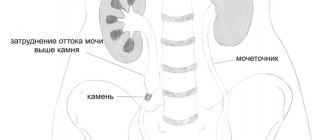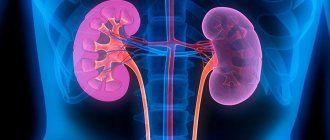Hydronephrosis is also called hydrocele of the kidney, since with this disease the outflow of urine in the area of the calyx and pelvis of the organs is disrupted. As a result, these parts of the kidneys expand, which can ultimately lead to irreversible changes (atrophy) in the tissues of these paired organs. Hydronephrosis often develops against the background of urolithiasis, kidney tumors, injuries to the urinary system and other diseases. Damage to the calyx and pelvis of the kidneys causes characteristic symptoms of hydronephrosis in humans.
Features of the course of hydronephrosis
Hydronephrosis is considered one of the most common urological diseases in young children. But adults also face this problem, especially those over 60 years of age. Among such patients, men are most often found. Pregnant women are also at risk.
The peculiarity of hydronephrosis is that at an early stage the disease does not cause serious disorders. Only in isolated cases can renal colic, frequent urination and a feeling of heaviness on the part of the affected kidney be observed. As the disease progresses, a dull aching pain appears in the lumbar region. Symptoms of hydronephrosis of the left and right kidneys in an adult are practically indistinguishable. The only exception is pain arising from the affected organ.
Symptoms of kidney hydronephrosis
With hydronephrosis, stagnation of urine occurs, which causes the renal pelvis and calyces to stretch as fluid accumulates in them. This leads to an increase in the volume of the kidneys themselves and a decrease in their function by 30-40%. Against this background, there is an increase in blood pressure, which becomes constantly elevated as the disease progresses. Additionally, the person suffers from morning renal edema. At a later stage, they are observed not only in the eye area, but throughout the body.
Other characteristic signs of kidney hydronephrosis in adults:
- pain in the lumbar region;
- discomfort in the lower and middle abdomen;
- elevated body temperature – 38 °C;
- headache and weakness;
- nausea and vomiting;
- fatigue and drowsiness.
An equally significant group of symptoms of hydronephrosis in adults are urinary disorders. They can manifest themselves in the form of a decrease in the volume of urine excreted, which is explained by a violation of its outflow. The urine produced takes on a dark, cloudy hue.
Primary and secondary hydronephrosis
Signs of secondary and primary hydronephrosis are little distinguishable. The primary form of the disease is congenital and is associated with an abnormality of the pelvis, kidney tissue or ureter. Secondary hydronephrosis is acquired and develops as a complication against the background of other diseases. The difference in symptoms is that in the primary form they occur in childhood, and in the secondary form they occur at any age when the underlying disease has occurred, causing problems with the outflow of urine.
Signs of hydronephrosis on ultrasound
Often signs of hydronephrosis are detected on ultrasound, which is additionally performed to more accurately determine the cause of the disease. Ultrasound reveals expansion of the renal pelvis, which gives an increase in the organ by 15-20% of its original size. In later stages, organs can be almost double in size. They are a complex of multi-chamber cavities in which liquid can be traced.
Interpretation of kidney ultrasound
Interpreting kidney ultrasound is a responsible undertaking that must be entrusted to professionals. Trying to independently decipher the results of a kidney ultrasound and make a diagnosis for yourself puts you at risk of missing the true pathology and harming your health!
What indicators are taken into account when interpreting kidney ultrasound:
- Location and number of organs
- Size, shape and general condition of the kidneys
- Echogenicity (the ability of tissues to reflect ultrasound)
- Renal blood flow velocity (determined using Doppler ultrasound)
Interpretation of kidney ultrasound consists of comparing the diagnostic results obtained with normal values. Deviation from the norm may indicate the following pathologies:
- Nephroptosis (prolapse of the kidney)
- Pyelonephritis
- Congenital abnormalities (eg, missing kidney)
- Benign neoplasms
- Kidney cancer
Don't risk your health! Some of the pathologies detected by ultrasound are deadly - therefore, only a urologist should decipher the results!
Make an appointment with a urologist
If you have discovered one or more signs of hydronephrosis, contact our State Urology Center.
We invite you to make an appointment with a urologist at a convenient time. In our clinic you can undergo diagnosis and treatment of hydronephrosis free of charge as part of the compulsory medical insurance program. The sooner the disease is confirmed, the more effective the therapy will be. It is equally important to consult a doctor on time, as this reduces the risk of complications and generally improves the prognosis for recovery. October 19, 2020
Hakobyan Gagik Nersesovich - urologist, oncologist, MD, doctor of the highest category, professor
All the symptoms of the disease...
Events calendar
Kidney disease affects 10 percent of the Russian population, which is about 14 million people. What complicates the situation is that often there are no signs that would allow the patient to think about kidney disease. Nephrologist at the University Multidisciplinary Clinic, Ph.D., spoke about prevention, necessary examinations, as well as for which symptoms one should immediately seek medical help. Dmitry Elfimov. – Dmitry Anatolyevich, tell us what the kidneys suffer from most often?
– Most often, the kidneys suffer from hypothermia, diseases of other organs, as well as from many other factors - ecology, bad habits, stress and pace of life. Heredity (or predisposition) is of no small importance. On average, people's life expectancy has increased, and a long life in our time “accumulates” diseases.
– Which kidney diseases and their accompanying diseases are more common than others?
The most “popular” diseases: arterial hypertension, diabetes. These diseases push aside independent kidney diseases - glomerulonephritis and pyelonephritis.
– There is an opinion that the worst thing is to get your feet wet, because the kidneys are the first to react to it, and hypothermia is the main cause of kidney disease.
– Hypothermia is not always the main cause of kidney pathology. Yes, indeed, after hypothermia or an acute viral or bacterial infection of the upper respiratory tract (which often appears after hypothermia), kidney disease can be detected. No wonder the popular proverb says: “Keep your head cold, your stomach hungry, and your feet warm!”
– What are the first signs of kidney problems?
– As a rule, there are no signs that would allow the patient to think about kidney disease. The main thing that forces a patient to seek help from a doctor is pain. But the kidneys don’t hurt! Most even very serious kidney diseases are asymptomatic, which is why they are called “silent killers.” There are a lot of diseases, but among them there is no disease that does not affect the kidneys. Therefore, the manifestations of kidney diseases are different. The main and most common symptoms are swelling in the legs and face. The patient may feel discomfort in the kidney area. But often there is only general weakness.
– What examinations are recommended? Do I need to visit a doctor for prevention?
– Our country has launched a large-scale Medical Examination project, which should make our work easier in identifying diseases. But when it comes to the kidneys, not everything is so rosy. Nowadays, a lot of work is being done to introduce additional examination methods into medical examinations at the federal level.
The earliest marker of kidney damage is microalbuminuria. This indicator is already included in mandatory research in patients with diabetes. Microalbuminuria is a marker of damage to the endothelium, the layer lining internal organs from the inside, including the kidneys.
The second indicator is the blood creatinine level, which allows us to find out how the kidneys work and what their glomerular filtration rate is. Currently, the level of glomerular filtration is calculated using mathematical formulas and does not require a labor-intensive study of daily urine collection and determination using the Reberg-Tareev method.
Patients with kidney pathology should be monitored by a general practitioner, and regularly examined by a nephrologist 1-2 times a year or more often, depending on the disease. The frequency of examinations will be determined by the nephrologist himself.
–What treatment methods are there? Are they available to residents of Tyumen?
– Now there are day hospitals at clinics where the patient can undergo infusion therapy. If outpatient examination is not possible, treatment is carried out in a hospital setting.
The University Multidisciplinary Clinic has an outpatient nephrologist appointment and also operates a day hospital.
Surgical treatment in Tyumen is widely represented: there is a full range of possible interventions, which urologists successfully do.
Renal replacement therapy in our area is represented only by hemodialysis, that is, treatment with an artificial kidney apparatus.
Currently, in the south of the Tyumen region, dialysis is provided in a private institution in 4 departments: in Tyumen, Tobolsk and Ishim. In these institutions, patients receive all the necessary dialysis care within the framework of the tariff agreement under the compulsory medical insurance policy, free of charge.
– How to avoid frequent relapses of the disease?
– Avoid hypothermia, exacerbations of chronic and acute respiratory diseases.
– Is drinking regime important? What should you drink and in what quantities?
– A drinking regime must be mandatory, regardless of whether there is kidney pathology or not. A person needs 2 liters of fluid per day. As we all remember from school, the necessary chemical reactions take place in liquids. We need liquid to make urine, and with urine substances that the body does not need come out.
There are diseases when it is necessary to limit fluid intake, for example, diabetes mellitus, glomerulonephritis. But there are also diseases when relatively large volumes of urine are needed, for example, exacerbation of pyelonephritis.
Perhaps the most severe fluid restriction exists in patients with end-stage chronic renal failure receiving program hemodialysis (treatment with an artificial kidney machine). This is due to the absence of urine in these patients, and weight gain should not exceed 3 percent of body weight between procedures; large weight gain will inevitably lead to the progression of heart failure and even the death of the patient.
– Traditional medicine recommends herbal teas and infusions, how do you feel about this?
— In our practice, we widely use herbal medicine. There are a number of rules in herbal medicine: use only one herb, the herb must grow in the area where the patient was born and lives.
Thus, cranberries are widely used in nephrology. However, different diseases require different approaches to prescribing herbs.
– Is diet important for kidney disease and for prevention? What can be consumed and what should be excluded?
Diet in medicine comes first in the treatment of internal diseases. Carbohydrates have become widespread in our lives in large quantities, which quickly satiate us, but at the same time are easily stored in “reserves”. The other extreme is a diet high in protein, which is bad for your kidneys.
Therefore, to decide on your diet, you need to consult a doctor: a therapist, nutritionist, cardiologist, nephrologist or gastroenterologist. The diet will always depend on the disease and is prescribed individually.
– Is it possible to engage in sports and lead an active lifestyle for people who already have kidney disease? And for prevention
?
— We can consider sport in the form of physical activity. Of course, running over rough terrain will not be beneficial, since the kidneys do not like shaking. But everyone should have physical activity, and its volume will depend on the disease.
I always told my patients, even on dialysis: “Don’t get sick! Get well! Getting sick is expensive now! And this price is calculated not only in money, but also in the quality of future life!”
Authors:
Evgenia Shkarina, Anastasia Lapteva








